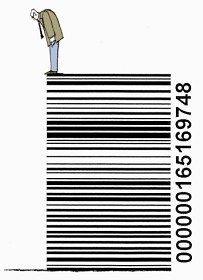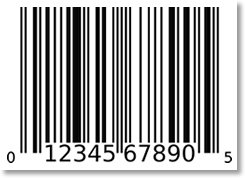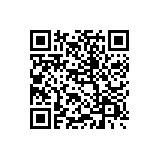History of the Bar Code
 The bar code, also referred to as a UPC (Universal Product Code), although that is just one type of bar code, was invented for inventory tracking purposes in stores.The bar code that is seen on so many products in stores of all kinds throughout the nation has its origins dating back to 1932 when a group of students at Harvard's School of Business Administration undertook a project that would make shopping by catalog easier for customers. All the customer had to do was removed a card from the catalog corresponding to the item they wanted to purchase, then hand that card to a clerk who placed the card into a mechanical reader. The reader contained the information on the product and its location in the storeroom, and the product would be immediately delivered to the checkout counter where the customer paid for it. The information on the card also updated the store's inventory information so that when the time came to reorder that product, the store owner or manager would know how many had to be ordered. The card system came in handy for keeping track of merchandise, and it was not long before an inventor and grocery store chain owner would collaborate on a project that would allow the information on that card to be applied directly to a given product. With the information created in the form of a code of some kind, that would make processing and inventory maintenance even easier.(1)
The bar code, also referred to as a UPC (Universal Product Code), although that is just one type of bar code, was invented for inventory tracking purposes in stores.The bar code that is seen on so many products in stores of all kinds throughout the nation has its origins dating back to 1932 when a group of students at Harvard's School of Business Administration undertook a project that would make shopping by catalog easier for customers. All the customer had to do was removed a card from the catalog corresponding to the item they wanted to purchase, then hand that card to a clerk who placed the card into a mechanical reader. The reader contained the information on the product and its location in the storeroom, and the product would be immediately delivered to the checkout counter where the customer paid for it. The information on the card also updated the store's inventory information so that when the time came to reorder that product, the store owner or manager would know how many had to be ordered. The card system came in handy for keeping track of merchandise, and it was not long before an inventor and grocery store chain owner would collaborate on a project that would allow the information on that card to be applied directly to a given product. With the information created in the form of a code of some kind, that would make processing and inventory maintenance even easier.(1)
The Bull's Eye Bar Code
The modern bar code as we now see on food and everyday household items resembled a series of concentric circles of varying widths. Conceived by Bernard Silver, a graduate student at Drexel Institute of Technology, the bar code was intended for use on items in Food Fair, a chain store. The president of Food Fair wanted some method developed to keep better track of the store's inventory, and when Silver overheard this, he took it upon himself to invent a solution for the popular food chain.
Along with Normal Woodland, a fellow graduate student at Drexel, they collaborated on the project and finally had their new invention patented and ready for use in 1949. Once the bar codes were attached to each food item, a scanner used at the checkout counter would read the information encased in each bar code. Each bar code had a distinct pattern, and that pattern would be unique to one particular item in the store, even if there was more than one of that item. The early bar code had four white lines affixed to a dark background, but over time more lines could be added to increase the number of classifications of items. This was important as it allowed more variations and patterns of lines to be used over time as new products were being invented and produced.(3)
Woodland originally wanted to use a special type of ink that would glow under ultraviolet light but the system had two drawbacks: one, it was expensive to print the codes, and second, it faded over time. Something more permanent was required for the bar code if it was to be attached to a product and left on the shelf of a store over time. The concept of a bar code in itself needed modification in the printing area, and Woodland spent some time improving his new invention, using money he made in the stock market. While he was improving on his new idea, the Morse code inspired him to create this bar code. The Morse code uses dots and dashes, which Woodland converted to thick and thin lines in the bar code. Once his invention was perfected, he filed a patent with Silver and called it "Classifying Apparatus and Method." Now that the bar code lines could be manipulated to create item classifications, it was ready to be used in stores everywhere. The patent was issued in 1952 and utilized a binary code that could easily be read by a scanner and easily translated into any language for inventory purposes.(4)
The Modern Bar Code
Much like Woodland and Silver's invention, the modern day bar code has a series of lines in distinct patters accompanied by binary numbers below them. These bar codes are generally rectangular in shape. Unfortunately neither Woodland nor Silver made their wealth on the bar code, as they had sold their patent to Philco, who later sold it to RCA in 1952, shortly after they received the patent papers. The two men did not receive a substantial amount, but the invention is invaluable as the bar code is used in every nation around the world wherever goods are sold. All that was needed was a faster machine to scan items containing the bar code, and that became possible through technology made available in the 1960's.(5)
The First Modern Scanning System
The first modern scanning system was installed by RCA at a Kroger's grocery store in 1972 after the industry held a nationwide conference, stating that the bar code was the wave of the future, allowing products to be scanned quickly and efficiently. By this time, other means of collecting product data were invented by David Collins, who created a railway car tracking system. Employed with Sylvania, reflective colors in the form of stripes became his variation of the bar code.(6) What was really innovative with his system, however, was the eventual use of a laser beam that could read the bar code. Hand held scanners held in grocery, department, and other stores use this very technology that evolved over time since the early days of Woodland and Silver. The concept of the bar code is invaluable but as with many modern inventions, had to wait for technology to catch up so that it could be properly work. All that really remained of the bar code was how many lines and digits would be used(7).
Uniform Product Code
 George Laurer was a consultant for IBM before he established the 12-digit bar code that is now used on products in stores. In 1971 the company's management asked Laurer if he could design an optical code that would be innovative for the grocery industry that would remain in use and eventually be adopted by other merchandise producing companies. Laurer also created a symbol to accompany the bar code and after three submitted proposals, the UPC bar code was born. Laurer also played a substantial role in the development of scanning equipment that would read each UPC symbol every time an item was purchased at the checkout counter. In the UPC bar code, The first 6 numbers starts with a 0 followed by the manufacturer's number, which is 5 numbers. The last 6 numbers identify the item the bar code is affixed to. The first product that bore Laurer's bar code was a pack of Wrigley's chewing gum sold at a Marsh supermarket in Troy, Ohio. (8)
George Laurer was a consultant for IBM before he established the 12-digit bar code that is now used on products in stores. In 1971 the company's management asked Laurer if he could design an optical code that would be innovative for the grocery industry that would remain in use and eventually be adopted by other merchandise producing companies. Laurer also created a symbol to accompany the bar code and after three submitted proposals, the UPC bar code was born. Laurer also played a substantial role in the development of scanning equipment that would read each UPC symbol every time an item was purchased at the checkout counter. In the UPC bar code, The first 6 numbers starts with a 0 followed by the manufacturer's number, which is 5 numbers. The last 6 numbers identify the item the bar code is affixed to. The first product that bore Laurer's bar code was a pack of Wrigley's chewing gum sold at a Marsh supermarket in Troy, Ohio. (8)
One last addition to the UPC bar code was a thirteenth digit that would allow the UPC bar code to be used in any nation in the world, as this digit would identify the country a particular UPC bar code was sold in. With this newest format, the UPC bar code could now be internationally used.(9)
The UCC Council
The UCC, or Uniform Code Council, was first organized as the Uniform Grocery Product Code Council in the late 1960's by grocery chains who sought an easy solution for faster checkout procedures. With Woodland and Silver's new bar code invention, equipment had to be invented to read the bar code, and grocery chain owners wanted to be able to save time and money by allowing the checkout counter to be as brief as possible for both the clerks and consumers. Eventually renaming itself to the Uniform Product Code Council in 1974, this non-profit organization helped establish a uniform code that could be applied to any product that could be used for resale. In 1984 the organization shortened its name to Uniform Code Council to resonate the latest Uniform
Communication Standards that allowed data interchange from the information in the code read by scanners to easily transmit between computers for merchandise reordering.(10)
The EAN/UPC Bar Code
With an increasing global market, one of the main priorities in business was to establish a series of standards that would improve supply demands in any type of service or chain store anywhere in the world. One important standard is the EAN/UPC Bar Code which allows businesses to operate more efficiently. Approximately 5 billion of these bar codes are read by scanners in the world every day which allows services and chain stores to track what inventory has been sold and needs to be ordered. With global sourcing dominating the market, the UPC Bar Code can be found on any product made in one country, and then shipped to another country to be sold without any extra product identification information having to be added. That is a global standard of business in action!(11)
2D Bar Codes
 A 2D bar code is a two-dimensional graphic that stores information both horizontally and vertically. Unlike the traditional UPC bar code, the 2D code can store up to 7,089 characters within it and can access data quickly. The first 2D bar code was created by Intermec Corporation in 1988 and was named Code 49.(12) The 2D bar code that is seen most frequently was developed by Denso-Wave in 1994, a Japanese company. This 2D code is also referred to as a QR code, or Quick Response code. Because it has been placed in the public domain, a QR code can easily be generated on the Internet through a site such as qrcode.kaywa.com or www.barcode.com.(13)
A 2D bar code is a two-dimensional graphic that stores information both horizontally and vertically. Unlike the traditional UPC bar code, the 2D code can store up to 7,089 characters within it and can access data quickly. The first 2D bar code was created by Intermec Corporation in 1988 and was named Code 49.(12) The 2D bar code that is seen most frequently was developed by Denso-Wave in 1994, a Japanese company. This 2D code is also referred to as a QR code, or Quick Response code. Because it has been placed in the public domain, a QR code can easily be generated on the Internet through a site such as qrcode.kaywa.com or www.barcode.com.(13)
2D bar codes can be placed on much more than just products for sale, however. Some website owners place one on their site, and because the 2D code can easily be generated on the Internet, all the website owner has to do is place the HTML coding link inside the web document so that the graphic is visible to all who visit the site. Many companies also use the 2D code on shipping labels, as well as on advertising pages and signs. At present, 2D bar codes seem to be the wave of the future with their capacity to hold more character data than the average UPC bar code. This square shaped graphic code may seem like a far cry form the first bull's-eye code but both have their own unique heritage in the word of bar codes.(14)
(1) http://www.adams1.com/history.html
(2) http://en.wikipedia.org/wiki/Barcode
(3) http://inventors.about.com/library/inventors/blbar_code.htm
(4) http://eh.net/encyclopedia/article/brown.bar_code
(5) http://www.nationalbarcode.com/history-of-barcode-scanners.htm
(6) Ibid
(7) http://laurerupc.com/
(8) http://en.wikipedia.org/wiki/George_J._Laurer
(9) http://bellsouthpwp.net/l/a/laurergj/UPC/upc_work.html
(10) http://www.cummingsdesign.com/bar_codes101_UCC_History.htm
(11) http://www.gs1.org/
(12) http://searchmobilecomputing.techtarget.com/definition/2D-barcode
(13) http://en.wikipedia.org/wiki/QR_Code
(14) http://www.barcode.com/microsoft-to-use-colorful-barcodes.html
Was this article useful? Subscribe to our weekly(ish) email newsletter to receive more great articles about bar code technology.
Follow us on Twitter to get daily updates: Barcode.com on Twitter
Other articles that may interest you:
How to Put Bar codes on Your Products
Need bar code products? Click on one of the options on the left side menu of this screen. :)
